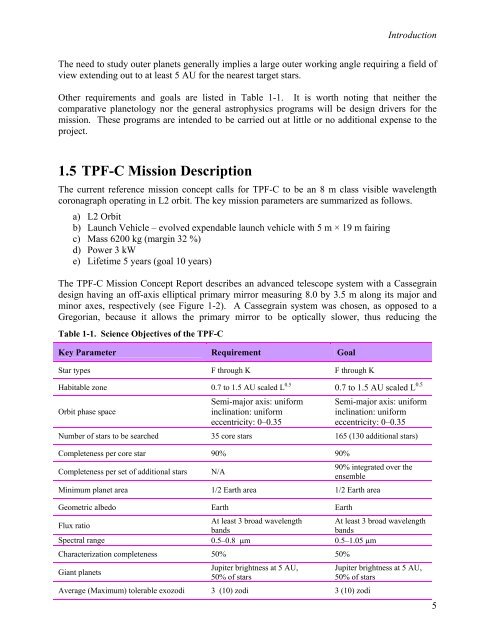TPF-C Technology Plan - Exoplanet Exploration Program - NASA
TPF-C Technology Plan - Exoplanet Exploration Program - NASA
TPF-C Technology Plan - Exoplanet Exploration Program - NASA
You also want an ePaper? Increase the reach of your titles
YUMPU automatically turns print PDFs into web optimized ePapers that Google loves.
Introduction<br />
The need to study outer planets generally implies a large outer working angle requiring a field of<br />
view extending out to at least 5 AU for the nearest target stars.<br />
Other requirements and goals are listed in Table 1-1. It is worth noting that neither the<br />
comparative planetology nor the general astrophysics programs will be design drivers for the<br />
mission. These programs are intended to be carried out at little or no additional expense to the<br />
project.<br />
1.5 <strong>TPF</strong>-C Mission Description<br />
The current reference mission concept calls for <strong>TPF</strong>-C to be an 8 m class visible wavelength<br />
coronagraph operating in L2 orbit. The key mission parameters are summarized as follows.<br />
a) L2 Orbit<br />
b) Launch Vehicle – evolved expendable launch vehicle with 5 m × 19 m fairing<br />
c) Mass 6200 kg (margin 32 %)<br />
d) Power 3 kW<br />
e) Lifetime 5 years (goal 10 years)<br />
The <strong>TPF</strong>-C Mission Concept Report describes an advanced telescope system with a Cassegrain<br />
design having an off-axis elliptical primary mirror measuring 8.0 by 3.5 m along its major and<br />
minor axes, respectively (see Figure 1-2). A Cassegrain system was chosen, as opposed to a<br />
Gregorian, because it allows the primary mirror to be optically slower, thus reducing the<br />
Table 1-1. Science Objectives of the <strong>TPF</strong>-C<br />
Key Parameter Requirement Goal<br />
Star types F through K F through K<br />
Habitable zone 0.7 to 1.5 AU scaled L 0.5 0.7 to 1.5 AU scaled L 0.5<br />
Orbit phase space<br />
Semi-major axis: uniform<br />
inclination: uniform<br />
eccentricity: 0–0.35<br />
Semi-major axis: uniform<br />
inclination: uniform<br />
eccentricity: 0–0.35<br />
Number of stars to be searched 35 core stars 165 (130 additional stars)<br />
Completeness per core star 90% 90%<br />
Completeness per set of additional stars N/A<br />
90% integrated over the<br />
ensemble<br />
Minimum planet area 1/2 Earth area 1/2 Earth area<br />
Geometric albedo Earth Earth<br />
At least 3 broad wavelength At least 3 broad wavelength<br />
Flux ratio<br />
bands<br />
bands<br />
Spectral range 0.5–0.8 μm 0.5–1.05 μm<br />
Characterization completeness 50% 50%<br />
Giant planets<br />
Jupiter brightness at 5 AU,<br />
50% of stars<br />
Average (Maximum) tolerable exozodi 3 (10) zodi 3 (10) zodi<br />
Jupiter brightness at 5 AU,<br />
50% of stars<br />
5
















